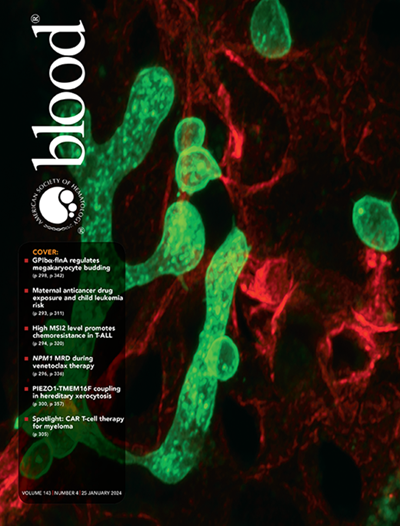TRIMM-2研究中,Talquetamab联合daratumumab治疗复发或难治性多发性骨髓瘤
IF 23.1
1区 医学
Q1 HEMATOLOGY
引用次数: 0
摘要
Talquetamab是一种针对复发/难治性多发性骨髓瘤(RRMM)的gprc5d靶向双特异性抗体,与daratumumab联合治疗可能比单独治疗更深入、更持久。在1b期TRIMM-2研究中,RRMM患者(至少有3个先前的治疗线或对蛋白酶体抑制剂和免疫调节药物双重难治性治疗)接受每周0.4 mg/kg (QW;“QW队列”)或每隔一周0.8 mg/kg (Q2W;“Q2W队列”)皮下注射加达拉图单抗1800 mg(每个批准的时间表)。主要终点是安全性。次要终点包括总体反应和反应持续时间。无进展生存期是一个探索性终点。65例患者(既往治疗中位数为5条线;61.5%为三级难治性;24.6%为双特异性抗体暴露)接受了talquetamab + daratumumab (QW, n = 14; Q2W, n = 51;中位随访:18.6个月)。最常见的不良事件是口腔事件、皮肤事件、细胞因子释放综合征和感染。3/4级事件发生率为81.5%。Q2W队列中有2例患者出现剂量限制性毒性(3级口腔炎/口腔黏膜炎和3级黄斑丘疹)。71.4% (QW队列)和82.4% (Q2W队列)的患者出现了应答。每个队列的中位无进展生存期分别为23.3个月和21.2个月。药效学结果表明,达拉单抗的免疫调节作用通过减少免疫抑制细胞,有助于为他克他单抗创造有利的环境。Talquetamab + daratumumab在重度预处理患者中显示出良好的疗效结果,安全性与每种药物作为单药治疗一致。ClinicalTrials.gov ID: NCT04108195。本文章由计算机程序翻译,如有差异,请以英文原文为准。
Talquetamab plus daratumumab for the treatment of relapsed or refractory multiple myeloma in the TRIMM-2 study.
Talquetamab, a GPRC5D-targeting bispecific antibody for relapsed/refractory multiple myeloma (RRMM), plus daratumumab may lead to deeper and more durable responses than either therapy alone. In the phase 1b TRIMM-2 study, patients with RRMM (at least 3 prior lines of therapy or double refractory to a proteasome inhibitor and an immunomodulatory drug) received subcutaneous talquetamab 0.4 mg/kg weekly (QW; "QW cohort") or 0.8 mg/kg every other week (Q2W; "Q2W cohort") plus daratumumab 1800 mg per the approved schedule. The primary end point was safety. Secondary end points included overall response and duration of response. Progression-free survival was an exploratory end point. Sixty-five patients (median 5 prior lines of therapy; 61.5% triple-class refractory; 24.6% bispecific antibody-exposed) received talquetamab plus daratumumab (QW, n = 14; Q2W, n = 51; median follow-up: 18.6 months). Most common adverse events were oral events, skin events, cytokine release syndrome, and infections. Grade 3/4 events occurred in 81.5%. Two patients had dose-limiting toxicities, both in the Q2W cohort (grade 3 stomatitis/oral mucositis and grade 3 maculopapular rash). Responses occurred in 71.4% (QW cohort) and 82.4% (Q2W cohort) of patients. Median progression-free survival was 23.3 and 21.2 months, respectively, in each cohort. Pharmacodynamic results suggest the immunomodulatory action of daratumumab contributes to a conducive environment for talquetamab by reducing immunosuppressive cells. Talquetamab plus daratumumab demonstrated promising efficacy outcomes in heavily pretreated patients, with a safety profile consistent with each agent as monotherapy. ClinicalTrials.gov ID: NCT04108195.
求助全文
通过发布文献求助,成功后即可免费获取论文全文。
去求助
来源期刊

Blood
医学-血液学
CiteScore
23.60
自引率
3.90%
发文量
955
审稿时长
1 months
期刊介绍:
Blood, the official journal of the American Society of Hematology, published online and in print, provides an international forum for the publication of original articles describing basic laboratory, translational, and clinical investigations in hematology. Primary research articles will be published under the following scientific categories: Clinical Trials and Observations; Gene Therapy; Hematopoiesis and Stem Cells; Immunobiology and Immunotherapy scope; Myeloid Neoplasia; Lymphoid Neoplasia; Phagocytes, Granulocytes and Myelopoiesis; Platelets and Thrombopoiesis; Red Cells, Iron and Erythropoiesis; Thrombosis and Hemostasis; Transfusion Medicine; Transplantation; and Vascular Biology. Papers can be listed under more than one category as appropriate.
 求助内容:
求助内容: 应助结果提醒方式:
应助结果提醒方式:


